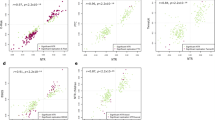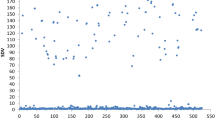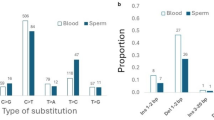Abstract
In humans, spontaneous DZ twinning is known to have a genetic basis. A prior investigation in the Flemish and Dutch population showed that the phenotype of ‘having DZ twins’ was consistent with an autosomal monogenic dominant model, with a gene frequency of 3.5% and a female-specific lifetime penetrance of 10%. Recessive, X-linked, polygenic and sporadic models were rejected. This study reports on a genome-wide scan of 14 Flemish families containing 57 mothers of spontaneous DZ twins. Two-point linkage analysis using the autosomal dominant model showed nine chromosomal regions with a LOD score around 1. After multipoint linkage analysis, including heterogeneity, three chromosomes continued to give high LOD scores. These regions were further haplotyped with additional markers at 1 cM distance. The multipoint analysis was not in favour of linkage of the DZ twinning trait in most candidate genes and other regions (LOD score < −2) under the genetic model of autosomal dominance.
To further evaluate the evidence for linkage given some uncertainty about the correct mode of inheritance of twinning susceptibility other models of inheritance were tested. Results of this analysis showed all models gave highest LOD scores under dominant models.
If heterogeneity among the families is taken into account, the peaks that were observed on chromosome 2, 7 and 18 could well contain a potential gene contributing to DZ twinning. These results give suggestive evidence that the mode of inheritance of DZ twinning is probably more complex than was originally expected.
Similar content being viewed by others
Log in or create a free account to read this content
Gain free access to this article, as well as selected content from this journal and more on nature.com
or
References
Montgomery GW, Crawford AM, Penty JM et al: The ovine Booroola fecundity gene (FecB) is linked to markers from a region of human chromosome 4q. Nat Genet 1993; 4: 410–414.
Davis GH, McEwan JC, Fennessy PF, Dodds KG, Farquhar PA : Evidence for the presence of a major gene influencing ovulation rate on the X chromosome of sheep. Biol Reprod 1991; 44: 620–624.
Lewis CM, Healey SC, Martin NG : Genetic contribution to DZ twinning. Am J Med Genet 1996; 61: 237–246.
Bulmer MG : The Biology of Twinning in Man. Oxford: Clarendon, 1970.
Meulemans WJ, Lewis CM, Boomsma DI et al: Genetic modelling of dizygotic twinning in pedigrees of spontaneous dizygotic twins. Am J Med Genet 1996; 61: 258–263.
Meulemans WJ, Lewis CM, Boomsma DI et al: Segregation analysis of dizygotic twinning in pedigrees of dizygotic twins conceived after artificial induction of ovulation. Am J Hum Genet 1994; 55: A158.
Loos R, Derom C, Vlietinck R et al: The East Flanders Prospective Twin Survey (Belgium): a population-based register. Twin Res 1998; 1: 167–175.
Peeters H, Van Gestel S, Vlietinck R et al: Validation of a telephone zygosity questionnaire in twins of known zygosity. Behav Genet 1998; 28: 159–163.
Jawaheer D, Seldin MF, Amos CI et al: A genomewide screen in multiplex rheumatoid arthritis families suggests genetic overlap with other autoimmune diseases. Am J Hum Genet 2001; 68: 927–936.
Ott J : Computer-simulation methods in human linkage analysis. Proc Natl Acad Sci USA 1989; 86: 4175–4178.
Weeks D, Ott J, Lathrop G : SLINK: a general simulation program for linkage analysis. Am J Hum Genet 1990; 47: A204.
Sobel E, Lange K : Descent graphs in pedigree analysis: applications to haplotyping, location scores, and marker-sharing statistics. Am J Hum Genet 1996; 58: 1323–1337.
Montgomery GW, Duffy DL, Hall J et al: Mutations in the follicle-stimulating hormone receptor and familial dizygotic twinning. Lancet 2001; 357: 773–774.
Göring H, Ott J : Verification of sib relationship without knowledge of parental genotypes. Am J Hum Genet 1995; 57: A192.
Gilfillan CP, Robertson DM, Burger HG et al: The control of ovulation in mothers of dizygotic twins. J Clin Endocrinol Metab 1996; 81: 1557–1562.
Nylander PP : Serum levels of gonadotrophins in relation to multiple pregnancy in Nigeria. J Obstet Gynaecol Br Commonw 1973; 80: 651–653.
Lockwood GM, Muttukrishna S, Ledger WL : Inhibins and activins in human ovulation, conception and pregnancy. Hum Reprod Update 1998; 4: 284–295.
Busjahn A, Knoblauch H, Faulhaber HD et al: A region on chromosome 3 is linked to dizygotic twinning. Nat Genet 2000; 26: 398–399.
Hasbargen U, Lohse P, Thaler CJ : The number of dichorionic twin pregnancies is reduced by the common MTHFR 677C-->T mutation. Hum Reprod 2000; 15: 2659–2662.
Fabre S, Pierre A, Pisselet C et al: The Booroola mutation in sheep is associated with an alteration of the bone morphogenetic protein receptor-IB functionality. J Endocrinol 2003; 177: 435–444.
Mukhopadhyay N, Almasy L, Schroeder M, Mulvihill W, DE W : Mega2, a data-handling program for facilitating genetic linkage and association analyses. Am J Hum Genet 1999; 65: A436.
Ott J : Analysis of Human Genetic Linkage. Baltimore: Johns Hopkins University Press, 1999.
Derom C, Groenen P, Vlietinck R : Follicle-stimulating-hormone receptor and twinning. Lancet 2001; 357: 230–231, author reply 231–232.
Duffy D, Montgomery G, Treloar S et al: IBD sharing around the PPARG locus is not increased in dizygotic twins or their mothers. Nat Genet 2001; 28: 315.
Montgomery GW, Zhao ZZ, Morley KI et al: Dizygotic twinning is not associated with methylenetetrahydrofolate reductase haplotypes. Hum Reprod 2003; 18: 2460–2464.
Dizier MH, Babron MC, Clerget-Darpoux F : Conclusion of LOD-score analysis for family data generated under two-locus models. Am J Hum Genet 1996; 58: 1338–1346.
Campbell D : Natural factors influencing multiple gestation; in Blickstein I, Keith LG (eds): Multiple pregnancy: epidemiology, gestation & perinatal outcome. London: New York, Taylor & Francis, 2005, pp 87–93.
Acknowledgements
This research was supported by the Fund for Scientific Research – Flanders (G.0408.99) and Twins, a non-profit Association for Scientific Research in Multiple Births. We thank all families for their enthusiastic cooperation.
Author information
Authors and Affiliations
Corresponding author
Rights and permissions
About this article
Cite this article
Derom, C., Jawaheer, D., Chen, W. et al. Genome-wide linkage scan for spontaneous DZ twinning. Eur J Hum Genet 14, 117–122 (2006). https://doi.org/10.1038/sj.ejhg.5201522
Received:
Revised:
Accepted:
Published:
Issue date:
DOI: https://doi.org/10.1038/sj.ejhg.5201522
Keywords
This article is cited by
-
A major QTL at the LHCGR/FSHR locus for multiple birth in Holstein cattle
Genetics Selection Evolution (2021)
-
Genetic control of multiple births in low ovulating mammalian species
Mammalian Genome (2012)



